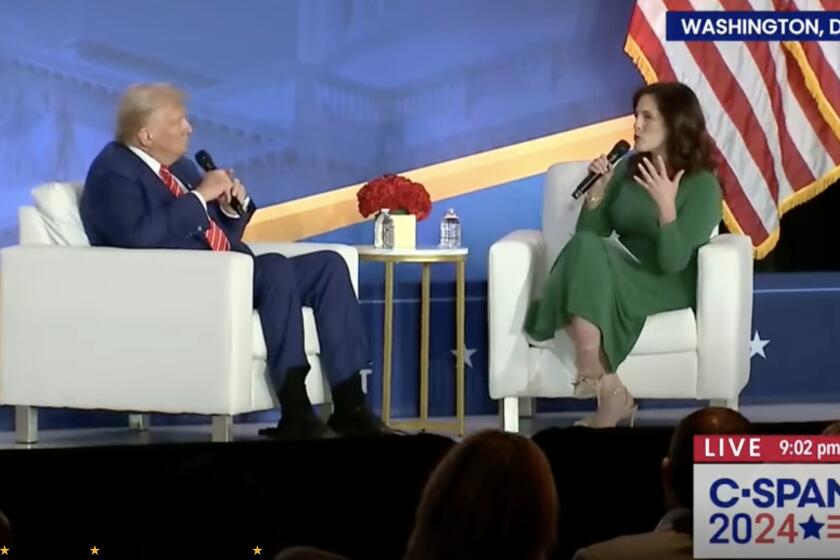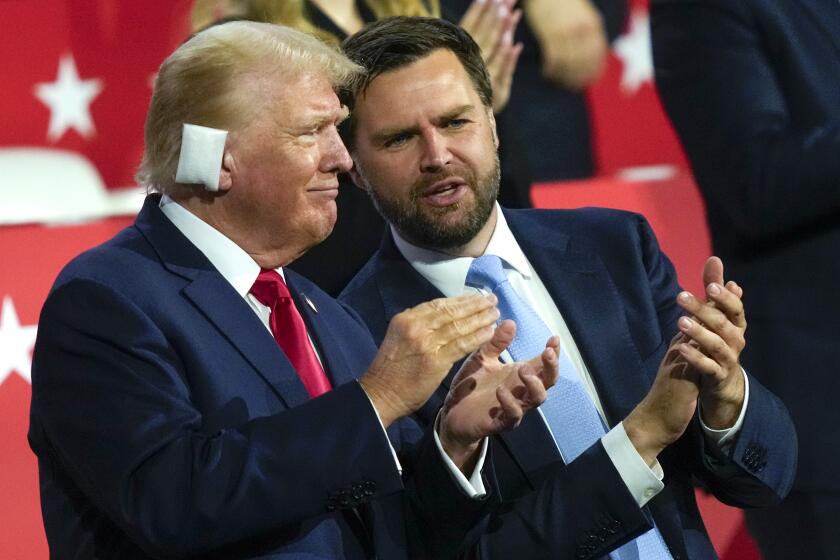Column: Trump’s assault on science will make Americans dumber and sicker

- Share via
Why does Donald Trump disrespect science?
The question arises because so much of his attempted dismantling of the federal government has been aimed at scientific agencies.
His nominee for Secretary of Health and Human Services, Robert F. Kennedy Jr., is a leading anti-vaccine activist and an exponent of loopy, fact-free scientific theories and health remedies that are unproven or those that have been proven useless (such as hydroxychloroquine and ivermectin as COVID-19 treatments).
There’s a fire sale on American academics right now.
— Carl Bergstrom, University of Washington
He has spoken out against the fluoridation of drinking water, which the CDC has identified as one of the 10 great public health achievements of the 20th century, along with vaccination, family planning and recognition of tobacco’s health dangers.
The Centers for Disease Control and Prevention was ordered to take down web pages that provided patients and healthcare providers with crucial information about a panoply of medical conditions and its crucial Morbidity and Mortality Weekly Report, an indispensable statistical publication didn’t go out as scheduled for the first time in its 60-year history.
Get the latest from Michael Hiltzik
Commentary on economics and more from a Pulitzer Prize winner.
You may occasionally receive promotional content from the Los Angeles Times.
The most comprehensive sally, of course, is the administration’s drastic and abrupt cut in funding by the National Institutes of Health.
On Feb. 7, the NIH announced that its payments for “indirect” research costs, which sometimes come to 60% or more of grants’ direct costs, would be cut to 15%, a cutback of billions of dollars from the budgets of leading academic institutions.
The cuts were to go into effect three days later, leaving grant recipients thunderstruck. Indirect costs include overhead costs of maintaining buildings housing labs and general administration expenses.
On the surface, these attacks make no practical sense. They can only erode America’s standing as a paragon of leading-edge science; the CDC is a source of indispensable information about disease outbreaks, and the NIH the world’s largest funding source for biomedical research — “the greatest engine of biomedical research ever created,” in the words of oncologist and veteran pseudoscience debunker David Gorski. Whether the NIH can retain that distinction is now in question.
Trump’s actions threaten to trigger a brain drain from the U.S., as researchers in important laboratories have begun looking for jobs abroad or started to field recruitment offers.
“There’s a fire sale on American academics right now,” Carl Bergstrom of the University of Washington told STAT News. Others suggested that the funding cuts would open the door to more scientific leadership by America’s global competitors, specifically China.
Water fluoridation revolutionized dentistry, especially for children. Why does the right wing think it’s a problem?
The administration initially tried to give the NIH cuts a partisan coloration, suggesting that academic centers in blue states are fattening up on “indirect” research funding. The NIH illustrated its tweet announcing the slash in indirect cost funding with a graphic citing the indirect rate claimed by Harvard (located in Massachusetts), Yale (Connecticut) and Johns Hopkins (Maryland). All receive indirect-cost rates of more than 60% on top of their direct grants.
The notion that the NIH cuts would strike hardest at blue-state institutions didn’t survive its first contact with reality. The truth is that academic centers in red states may be even more dependent on indirect funding than the rich institutions targeted by the NIH tweet.
Sen. Katie Britt (R-Ala.) immediately went public with an appeal that the NIH turn to a “targeted approach” on the cutbacks “in order to not hinder life-saving, groundbreaking research at high-achieving institutions like those in Alabama.”
The University of Alabama at Birmingham ranked in the top 5% of all U.S. universities in federally funded research in 2023, and in the top 1% last year. “People need to be reminded that UAB is not just the largest employer in the city, it’s the largest employer in the state,” Birmingham Mayor Randall Woodfin said.
Academic leaders in Georgia noted that the $780 million received in the last fiscal year by Georgia institutions produced an estimated $2 billion in economic impact. All that was placed at risk by the threatened NIH cutback.
Indeed, the importance of NIH funding to all states was underscored in the lawsuit brought Tuesday in Massachusetts federal court by 22 blue states, including California, to block the NIH cutback. They sought a temporary restraining order blocking the cutback — and asked that the order apply only in their states, which was granted by Judge Angel Kelley.
Sean Kirkpatrick ran the government’s investigation into UFOs, so he knows a lot about how misinformation and disinformation become grist for Congress and an unthinking news media
That sounded like a sly attempt by the plaintiffs to put more pressure on the red states to make their own case for the wholesale destructiveness of the NIH order, in public. (Kelley expanded her order nationwide in response to a second lawsuit brought by hospitals, public health organizations and universities, including the University of California.)
How important is the NIH to the innovativeness of American bioscience and the health of the public? A 2020 study found that NIH funding played a role in research associated with every new drug approved by the Food and Drug Administration from 2010 to 2019. The funding produced 22,000 patents.
So what underlies Trump’s war on science?
One can parse the arguments made by Trump and his GOP acolytes to figure it out. Some of it is ideological. Science done right, like nature itself, is impervious to ideology. The scientific method is an asymptotic process aimed at determining natural truths. Preexisting notions are subjected to examination and testing; if they fail the test, they’re revised or discarded.
Its mechanisms, including anonymous peer review and open debate, are “explicitly designed to counter human self-deception,” the psychologist Steven Pinker told Chris Mooney, author of the 2005 book “The Republican War on Science.”
“Powerful people will tend to use their their authority to ... suppress inconvenient opposition,” Pinker said. “You try to set up the game of science so that the truth will out despite this ugly side of human nature.”
Anti-science ideology tends to protect powerful economic incumbents. Those who call global warming a “hoax,” including Trump, are advancing the interests of fossil fuel companies; the decades-long effort to cast doubt on the links between smoking and disease profited the tobacco industry.
This project involves casting doubt on expertise. That accounts for the disgraceful smearing of Anthony Fauci, the nation’s most distinguished epidemiological expert until his retirement from the NIH in 2023, by Republicans who absurdly tried to blame him for creating COVID-19.
Politicians and their henchpersons dismiss scientific expertise so they can substitute their own worldview without being challenged. Florida’s Republican Gov. Ron DeSantis tried to demonize Fauci in order to claim superior knowledge about how to combat COVID; never mind that his state ended up with one of the worst pandemic mortality rates in the land.
Donald Trump claims that schools are subjecting pupils to gender-changing surgery without their consent, which is his exclusive fantasy.
And never mind that Florida’s policies were so out of step with scientific understanding that in 2023 the heads of the CDC and Food and Drug Administration publicly upbraided DeSantis’ hand-picked state surgeon general, Joseph Ladapo, for his “misinterpretations and misinformation” about the safety of the COVID vaccines.
Trump’s participation in this undertaking isn’t new. It was vividly on display during his first term. He promoted the useless nostrum hydroxychloroquine and the deployment of UV light and disinfectants as remedies for COVID-19, then sidelined Fauci as a White House advisor when the latter proved insufficiently indulgent about Trump’s views.
He installed anti-abortion activists in key positions at HHS, perches from which they purveyed claims such as that condoms don’t protect against HIV or other sexually transmitted diseases and that abortions and contraceptives cause breast cancer, miscarriages and infertility. None of those assertions is true.
Trump accused the FDA’s scientists of being part of the “deep state” plotting to undermine his administration in the run-up to the 2020 election. At the Environmental Protection Agency and other agencies, he disbanded or sidelined scientific advisory panels.
Trump’s VP pick, J.D. Vance, wants Americans to have more kids. So why are he and Trump calling for an end to the vaccine mandates that keep kids healthy?
At the EPA and Interior Department, according to a report by the Union of Concerned Scientists, political appointees were required to review grants and contracts “to ensure that proposed research fits the administration’s political agenda.”
In 2017, the UCS report found, the CDC banned the use of the terms “vulnerable,” “entitlement,” “diversity,” transgender,” “fetus,” “evidence-based” and “science-based” in budget documents, prefiguring a similar ban implemented by the current administration.
The “culture of fear” instilled at several agencies led to “self-censorship among scientists and otherwise impedes their ability to work effectively or speak on important scientific issues,” UCS found.
Not all of this originated with Trump. Bowing to religious and partisan ideologues in 2001, George W. Bush restricted embryonic stem cell research. The policy was based on a misunderstanding of embryonic stem cell science, which made it, in Mooney’s words, “a policy based on science fiction.”
The Bush order did inspire California to establish the California Institute for Regenerative Medicine in 2004 with a $3-billion bond issue approved by voters. That might point the way to the continuation of crucial scientific research through state-level funding. Given that the NIH budget is about $46 billion a year, it’s unlikely that states can fully make up losses from Trump policymaking from their own budgets.
The only resistance against the administration’s anti-science agenda is coming from the courts. Of 58 lawsuits filed in federal courts so far in opposition to administration actions and policies, at least seven concern such issues as the deletion of web pages at the CDC and the funding cuts at NIH.
Thus far, according to the litigation tracker at justsecurity.org, judges have temporarily blocked the web deletions, the funding freeze imposed throughout the government, including at the science agencies and the cuts in “indirect” funding.
Trump’s war against science is only beginning. The scientific community will have to play a momentous role in the conflict. Let’s hope it’s up to the task.
s
More to Read
Get the latest from Michael Hiltzik
Commentary on economics and more from a Pulitzer Prize winner.
You may occasionally receive promotional content from the Los Angeles Times.















